Our chicks have now been here a full 24 hours, and they’ve all settled in very well. We weren’t at all surprised to see a large fluffy pile of snoozing babies this morning, especially after their big first day at the farm.
We did manage to take a few photographs. Some chicks were cooperative, others were clearly camera shy, or just downright suspicious of what was going on, but here’s a first close look at the farm’s new inhabitants.
Buff Orpington
A British standard breed, developed in 1880 by William Cook of Kent, England. A cold hardy breed, with hens weighing an average of 8lbs at maturity. Moderate brown egg layers with a quiet disposition. Until these chicks arrived, only had Buff Orpingtons here at Curbstone Valley, as we’re very fond of this breed.
Delaware
Developed by George Ellis in 1940 in Delaware. This is a standard American breed, once quite popular, but now listed as “threatened” by the American Livestock Breeds Conservancy. A docile breed, and good layers of large brown eggs. Mature hens weigh an average of 6.5 lbs. The Delawares are slightly lighter in coloration than the Buff Orpington chicks. As adults, the Delawares are white, with black barring in the hackle and tail.
Golden Laced Wyandotte
American standard breed that originated in Wisconsin. The chicks appear similar to the Partridge Plymouth Rocks, but with more dark coloration. The adults are a beautiful combination of rich golden bay laced with lustrous greenish black feathers, and are popular show birds. They are modest brown egg layers, weighing an average of 6.5 lbs as adults, and have unique rose-shaped combs.
Partridge Plymouth Rock
The baby chicks are a rich dark brown resembling the color of an expensive fur coat. Developed in New England in the 1800s, this is an American standard breed. The Plymouth Rock was once a common sight on the homestead. The partridge coloration is less common than the typical barred or whites, and is often sought after as a show bird. This is a docile, easily handled breed, and a modest brown egg layer. Hens typically weigh about 7.5 lbs.
Black Australorp
This standard breed originated in Australia, and was developed from Black Orpingtons imported from England. In 1920 a Black Australorp garnered much attention when she laid 364 eggs in 365 days! Not typical of the breed, but the Black Australorp is a good layer of light brown, medium sized, eggs. Hens are calm, make great mothers, and weigh an average of 6.5 lbs.
But wait…who are you?
Our hatchery likes to throw a ‘bonus’ rare or exotic breed chick in with their order. The chick is straight run (meaning we have no idea if it will be a hen or a rooster), and the breed is not disclosed by the hatchery (for fun we presume). We have no idea what breed this little chick is with the fuzzy legwarmers, but our best guess at the moment is a Silver Laced Cochin. If so, this is a relatively new variety, and the silver-laced color pattern is quite rare for the breed. Once we confirm who this little one is, we’ll let you know too!
We removed the newspaper this morning, and shot a little extra video (apologies for the red cast to the videos, it’s their heat lamp that causes the strange coloration).
Oh, alright…just one more video…they won’t stay this small for long!
One last note…apparently the hatchery also managed to sneak in an extra Buff Orpington chick, that we didn’t notice until last night. We were checking on the Delawares, as one had managed to catch her toe in the feeder earlier in the day (a poorly manufactured trough feeder, that has since been replaced), and we just wanted to double check that her toe came through the ordeal unscathed (it did!). We should have had 10 little blond chicks, 5 Delawares, and 5 Buff Orpingtons, but while sorting through them, we realized we had 11. That puts our chick total at 28!
We’ll try and do weekly updates on the chicks from now on…perhaps we’ll call them ‘Fowl Friday’ posts. It’s remarkable how much the chicks can change from week to week, and how their appearance overall will change as their feathers grow in. Stay tuned!

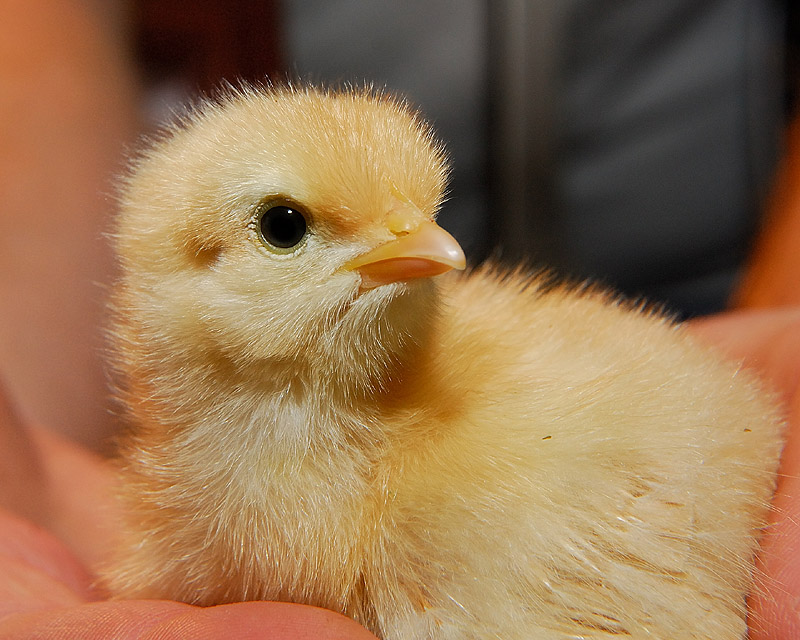
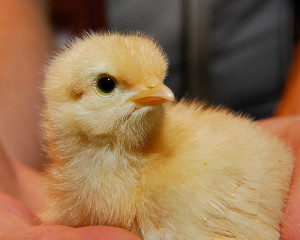
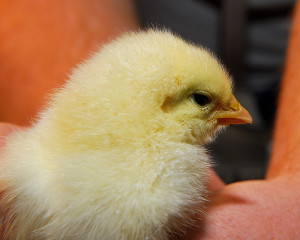
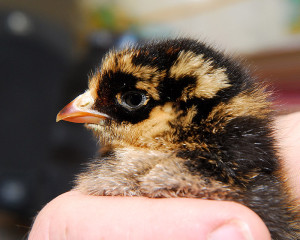

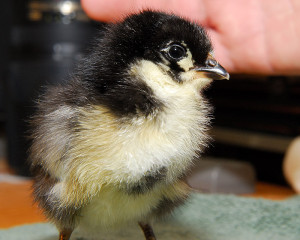
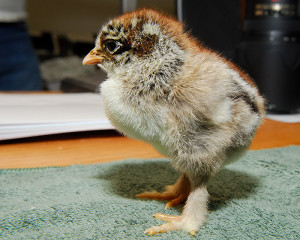







BTW your Blotanical feed problem seems to be sorted. Yesterday there was a Server Error at Google. Ate all the photos on my blog for few hours.
Oh my gosh the golden laced wyandotte… and all of them! I have have chicken coveting syndrome now…
.-= Eliza´s last blog ..How to Find Edible Morel Mushrooms (With Recipes) =-.
My 3 year old and I oohed and ahhed over the chicks. They are just so cute. I love the idea of Fowl Friday!
.-= Catherine´s last blog ..Flyaway – A book review. =-.
I cannot believe how cute these things are. And the fuzzy legged one. That would be the one for me. I have a cat that looks electrocuted, and yep, had to have her – all the odd lots!
.-= Jess´s last blog ..Before But No After =-.
I can’t decide which one is the cutest!
.-= Deborah at Kilbourne Grove´s last blog ..Happy Days Are Here Again! =-.
They already seem to have such personality CV! The Buff Orphington looks indignant about having her photo taken and the Australorp looks like one for a bit of a pose! I just adore the little ‘mystery prize’ with fluffy legwarmers and will be looking forward to all of the updates!
.-= Heidi´s last blog ..It is a Garden Show, but is it International? =-.
Could they be any cuter! Adorable photos … a delightful way to begin my day 🙂
.-= joey´s last blog ..EASTER DESSERT PERHAPS? ~ COCONUT CREAM CHEESECAKE =-.
Those chicks are adorable! I know if I brought any home, my little Westie would go nuts, though.
Fowl Friday – I love it! We recently joined a CSA that will give us 2 dozen eggs and 2 whole chickens a month, so we are enjoying others’ chicken experiences vicariously, as it were.
.-= villager´s last blog ..Early Spring Update =-.
I love the idea of Fowl Friday. I can’t wait for our chicks to arrive. We wait until the first of June when it is easier to maintain the proper heat in the henhouse. This year our order contains chicks for 3 neighbos, who all want different breeds. I hope we can tell one from the other.
.-= commonweeder´s last blog ..More Than Maple Farmers =-.
I sure hope that your leg-warmer chick is a Cochin!!! I had a Partridge Cochin hen that was the best bird ever. Can’t wait till we get things settled down a bit more here on our place and I can have a few hens. Will immediately look for Cochins. Great pictures and I loved the info abut the breeds! You have chosen wisely!
.-= Bonnie Story´s last blog ..Visit to Whitney Gardens in Brinnon, Part 2 =-.
I love chicks. They’re so cute and adorable. I’ve had a package of pink PEEPS sitting on my desk since ’06 🙂
.-= wiseace´s last blog ..House vs Machine =-.
Oh how wonderful. Last week one of my work colleagues brought in 2 of his little chicks for another work collegeague. He kept the 2 chicks in the pocket of his fleece through one meeting and it was so funny to hear little chirps coming from his pocket. After the meeting we got a big box and a heat plate and kept them warm in the box till hometime. I have not seen my friends chicks for nearly a week now and she wants me to feature them on my blog too – so I need to get over to her house soon once the weather improves to get some photos as they are just over a week old now.
You are going to have such a wonderful array of chickens at the farm plus a wonderful array of different coloured eggs each morning once they start to lay.
Oh my, I think I’m in love; I don’t know that I could pick one over the other for they are all adorable. It looks as though you have a couple feisty ones. 😉
.-= Diana (Di)´s last blog ..What’s In The Garden =-.
Legwarmers…heh! I can’t resist the urge to stick my hand through the screen, pick up the fuzziest chick and hold her to my cheek! What fuzzy little cuties.
.-= Christine´s last blog ..SF Garden Show: Natives 3.0 =-.
They are all adorable in this ‘chick’ phase;-) I like them all…but especially enjoyed seeing the colorful ones-other than yellow- as they are new to me. Glad the one little guy didn’t hurt his foot!
.-= Jan (Thanks For Today)´s last blog ..It’s Cherry Blossom Time in DC! =-.
Very cute. That’s a lot of eggs.
.-= melanie´s last blog ..The Secret to Maintaining a Healthy Rhubarb Plant =-.
Beautiful chicks! It’s amazing how snuggly a baby bird can appear! I envy your genetic background info–my chix are simply Nica mutts 🙂 Looking forward to Fowl Fri,
liz
.-= Liz´s last blog ..Landscaping take 2 =-.
Awww, how cute! When I played the videos, the dogs ran in to see what was chirping.
I’ve been developing serious “chicken lust,” as F. calls it, for a year now, and this post just added fuel to the fire. They’re so cute!! I especially want to cuddle the little guy with leg warmers, so sweet. Thank you for all the background info and the planned weekly updates, too, because eventually I *will* have chickens in the backyard, and I want to educate myself meanwhile.
.-= Meredith´s last blog ..the very air is loud with spring =-.
Oh goodness! Two surprises in your new batch of chickens. I must say that I love the idea of having a surprise chick and not knowing anything else about it. Life is too short to not enjoy a little unpredictability, don’t you think?
.-= Noelle/azplantlady´s last blog ..A Vegetable Garden…..Completed! =-.
Cute, cute, cute! Your baby chicks are lucky to have come home to Curbstone Valley. I like the little chick with the leg warmers. It will be fun to watch them grow.
.-= debsgarden´s last blog ..A Crime Scene on a Beautiful Day =-.
Dear CV, This is an utterly enchanting, and informative, posting. Who could possibly resist these tiny little chicks and so very appropriate for Easter time? They are, as I am sure that you know, a delight.
It is, I feel, particularly good that you have included the threatened ‘Delaware’, although my favourite would have to be the ‘Golden Laced Wyandotte’ which is especially sweet.
Thank you so much for the good wishes which you sent to me before my recent holiday. It was such a kind thought.
.-= Edith Hope´s last blog ..Get Ahead – Wear a Hat =-.
The Buff Orpington is so cute!